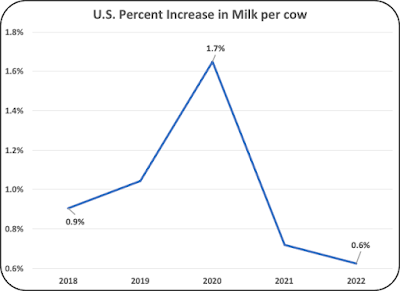There were fewer cows at the end of 2022 than 2021 (Chart I). But the decrease in cows was out weighted by the increase in milk per cow allowing an increase in milk production in 2022. In many ways, 2022 mimicked the year 2019, when cow numbers were down but milk was up. In both cases, the increase in milk was small. In 2019, the increase in milk over the prior year was .4 percent and in 2022 the increase was just .2 percent.
 |
| Chart I - Milk and Cows by Year |
The charts below on milk production are presented as 12-month moving averages as the month-to-month data are very volatile and is difficult to track.
USA milk production was flat in 2022 with a gain of just .2 percent. To have a supply of milk that will meet the growth of cheese and butter, increases in milk production need to be higher.
 |
| Chart II - USA Milk Production |
Table I lists the 10 largest dairy producing states. The largest growth by far occurred in Texas with the addition of 38,000 cows. The state with the largest decrease in cows was "next door" in New Mexico where cow numbers decreased by 51,000.
The long-term increase of cows in Texas over the last six years amounted to 180,000 cows. Texas has seen tremendous growth, primarily in milk for cheese and some of the growth has occurred to satisfy the needs of cheese plants in New Mexico where dairy production issues developed from the contaminated water supply.
California is the largest dairy state with Wisconsin in second place and both states have held these positions for a long time. Idaho finished in third place in 2020 and has held third place for the last three years. With increased cow numbers and increased milk production, Texas gained fourth place in 2022 . Next year, Texas will likely be in third place with a continuance of faster growth than Idaho. In 2018, New York once held third place, but has now slipped to fifth place with very slow growth.
When ranking states on milk production compared to cow numbers, there is only one change in the rankings. Michigan would rise to sixth largest from eighth. Michigan does have the highest milk per cow of any state. This will be covered in the milk per cow section later in this post.
 |
| Table I - Top Ten Dairy States based on Number of Dairy Cow and Milk Production |
Charts on milk production of the four largest dairy states are shown below.
 |
| Chart III - Milk Production in California |
Wisconsin shows minimal growth in 2022 with a gain of just .5 percent. In 2021, Wisconsin gained production by over three percent. Milk in Wisconsin is used primarily for cheese which is growing by two percent annually. New and expanded cheese plants in South Dakota may have reduced the Wisconsin milk production. South Dakota milk production has been growing by 15 percent annually for the last two years. In 2022, Wisconsin increased milk production 177 million pounds while South Dakota increased milk production by 542 million pounds.
 |
| Chart IV - Milk Production in Wisconsin |
Idaho milk production grew by 1.1 percent in 2022 and has averaged two percent annual growth over the last four years, close to the amount of growth in dairy domestic consumption and exports. The growth of Idaho milk production has been steady with gains each year.
 |
| Chart V - Milk Production in Idaho |
Now we come to fourth place Texas. The growth of milk production remains around 80 million pounds per year. Texas has averaged a growth rate of 6.5 percent over the last five years. Idaho and Texas milk production is currently at the same level of production. In the last three months of 2022, Texas milk production exceeded Idaho's milk production. There is a very good chance that the momentum of Texas growth will move them into third place in 2023. From there, it is still a very long climb to Wisconsin's milk production level.
 |
| Chart VI - Milk Production in Texas |
MILK PER COW
More milk per cow means more revenue with less work. Over the last five years, milk per cow has increased by an average of one percent annually. The gains have all been positive, but they have not provided consistent growth. The slow growth in 2022 mimics 2018/19 and could be considered a normal fluctuation.
 |
| Chart VII - U.S. Growth in Milk per Cow |
There is a huge difference in the size and growth rate of milk per cow by state. Table II shows the difference between the top five states and the bottom five states. From the highest milk per cow, Michigan, to the smallest milk per cow, Virginia, there is almost a 600 pound per month difference. On the average. the difference is over 400 pounds per month. That difference represents a lot of producer revenue, for each cow!
 |
| Table II - Ranking of the Highest and Lowest Milk per Cow |
The three charts below plot the growth of milk per cow over five years for three states. Michigan increased milk per cow by six percent and Texas gained seven percent. Virginia grew by just two percent during the five-year span.
 |
| Chart VII - Growth of Milk per Cow in Michigan |
 |
| Chart VIII - Growth of Milk per Cow in Texas |
 |
| Chart IX - Growth of Milk per Cow in Virginia |
The growth of milk per cow combined with increasing component rates can satisfy the needs of domestic consumers and exports. An upcoming post will cover the 2022 growth of components and the change in Somatic cell counts.


No comments:
Post a Comment